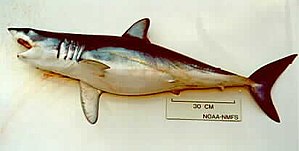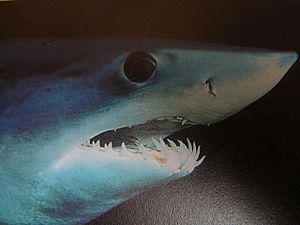Template:Taxobox The shortfin mako shark, Isurus oxyrinchus ("sharp nose"), is a large mackerel shark. Along with the closely related longfin mako (Isurus paucus) it is commonly referred to as a "mako shark".
Etymology
In 1809, Constantine Rafinesque first described shortfin mako and coined the name Isurus oxyrinchus (Isurus means "the same tail", oxyrinchus means "pointy snout"). "Mako" comes from the Māori language,& meaning either the shark or a shark tooth. It may have originated in a dialectal variation as it is similar to the common words for shark in a number of Polynesian languages—makō in the Kāi Tahu Māori dialect,& mangō in other Māori dialects,& "mago" in Samoan, ma'o in Tahitian, and mano in Hawaiian. The first written usage is in Lee & Kendall's Grammar and vocabulary of the language of New Zealand (1820), which simply states "Máko; A certain fish".&& Richard Taylor's A leaf from the natural history of New Zealand (1848) is more elaborate: "Mako, the shark which has the tooth so highly prized by the Maoris".&
Anatomy and appearance
Although both sexes grow at about the same rate, females are thought to have a longer life span, and generally grow larger and more robust. This species grows to an average length of Template:Convert&& and to a weight of approximately Template:Convert.& The largest reported male specimen weighed Template:Convert and measured Template:Convert, although a near record-sized female shortfin mako measuring Template:Convert weighed Template:Convert.& The shortfin is sleek and spindle-shaped with a long conical snout. Mako sharks have a more hydrodynamic shape than any shark other than the salmon shark. Combined with the lamnidae's typical high Cellular respiration muscle mass, this enables its spectacular speed and movements with great agility.
It has a crescent shaped caudal (tail) fin. The caudal base has a distinct caudal keel. Its second dorsal fin is much smaller than the first. The apexes of pectoral fin and first dorsal fin are rounded in younger makos. Shortfin mako skin has very abrasive placoid scales to reduce friction during swimming, like the dimples of a golf ball.
Distinguishing characteristics
- Teeth are visible even when the mouth is closed
- Teeth are long and slender with smooth-edged cusps
- Distinct countershading, dorsally blue and ventrally white
- Moderately short pectoral fins&&
- It also looks like a Great White Shark
- Curved teeth to hold prey
Ecology
Range and habitat
The shortfin mako inhabits offshore temperate and tropical seas worldwide. The closely related longfin mako shark, Isurus paucus, is found in the Gulf Stream or warmer offshore waters.
It is a pelagic species that can be found from the surface down to depths of Template:Convert, normally far from land though occasionally closer to shore, around islands or inlets.& One of only four known endothermic sharks, it is seldom found in waters colder than Template:Convert.&
In the western Atlantic it can be found from Argentina and the Gulf of Mexico to Browns Bank off of Nova Scotia. In Canadian waters these sharks are neither abundant nor rare. Swordfish are a good indication of shortfin makos as the former is a source of food and prefers similar environmental conditions.&
Shortfin makos travel long distances to seek prey or mates. In December 1998, a female tagged off California was captured in the central Pacific by a Japanese research vessel, meaning this fish traveled over Template:Convert. Another swam Template:Convert in 37 days, averaging Template:Convert a day.&
Feeding
The shortfin mako feeds mainly upon cephalopods, bony fishes including mackerels, tunas, bonitos, and swordfish, but it may also eat other sharks, porpoises, sea turtles, and seabirds. They hunt by lunging vertically up and tearing off chunks of their preys' flanks and fins. Makos swim below their prey, so they can see what is above and have a high probability of reaching prey before it notices. Biting the caudal peduncle can immobilize the prey. In Ganzirri and Isola Lipari, Sicily, shortfin makos have been found with amputated swordfish bills impaled into their head and gills, suggesting that swordfish seriously injure and likely kill makos. In addition, this location, and the late spring and early summer timing, corresponding to the swordfish's spawning cycle, suggests that these makos hunt while the swordfish are most vulnerable, typical of many predators.&
Shortfin consume 3% of its weight each day and takes about 1.5–2 days to digest an average-sized meal. By comparison, an inactive species such as the sandbar shark consumes 0.6% of its weight a day and takes 3 to 4 days to digest it. An analysis of the stomach contents of 399 male and female mako sharks ranging from Template:Convert suggest makos from Cape Hatteras to the Grand Banks prefer bluefish, constituting 77.5% of the diet by volume. The average capacity of the stomach was 10% of the total weight. Shortfin makos consumed 4.3% to 14.5% of the available bluefish between Cape Hatteras and Georges Bank.&
Shortfin over Template:Convert have interior teeth considerably wider and flatter than smaller makos, which enables them to prey effectively upon dolphins, swordfish, and other sharks.& An amateur videotape, taken in Pacific waters, shows a moribund spotted dolphin whose tail was almost completely severed, with a very large shortfin mako circling the dying dolphin. Makos also have the tendency to scavenge long-lined and netted fish.&
Its endothermic constitution partly accounts for its relatively great speed.&
Like other lamnid sharks, the shortfin mako has a heat exchange circulatory system that allows the shark to be 7-10°F (4-7°C) warmer than the surrounding water. This system enables makos to maintain at a stable, very high level of activity,& giving it an advantage over its cold-blooded prey.&
Behavior
The shortfin mako's speed has been recorded at Template:Convert with bursts of up to Template:Convert.& They can leap approximate Template:Convert high or higher in the air. Some scientists suggest that the biochemistry of shortfin mako can swim up to Template:Convert. Scientists are in debate exactly how fast the shortfin mako shark can swim, as well as which particular species are actually the champion ocean swimmers. This high-leaping fish is sought as game worldwide. There are cases when an angry mako jumped into a boat after having been hooked.
This shark is highly migratory.[citation needed]
Life history
Reproduction
The shortfin mako shark is a yolk-sac ovoviviparous shark, giving birth to live young. Developing embryos feed on unfertilized eggs in uterus during the 15 to 18 month gestation period. This is called (oophagy) (i.e. egg-eating). Shortfins do not engage in sibling cannibalism unlike the sand tiger shark (Carcharias taurus). The 4 to 18 surviving young are born live in the late winter and early spring at a length of about Template:Convert. It is believed that females may rest for 18 months after birth before mating again. Last and Stevens (2009) report shortfin makos bear young on average every 3 years.&
Lifespan
A landmark study by Natanson et al. (2006) has overturned previous highly inaccurate estimations of lifespan and sexual maturity in shortfin makos from the North Atlantic.& Natanson et al. (2006) aged vertebrae of 258 specimens and recorded:
- Maximum age of 29 years in males (260 cm FL)
- Maximum age of 32 years in females (335 cm FL)
- 50% sexual maturity at 8 years in males (185 cm FL)
- 50% sexual maturity at 18 years in females (275 cm FL)
Last and Stevens (2009) report similar findings.&
Relation to humans
Sustainable consumption
In 2010, Greenpeace International added the shortfin mako shark (Isurus oxyrinchus or mackerel shark) to its seafood red list. "The Greenpeace International seafood red list is a list of fish that are commonly sold in supermarkets around the world, and which have a very high risk of being sourced from unsustainable fisheries."&
Captivity
Of all recorded attempts to keep pelagic shark species in captivity, the shortfin mako has fared the poorest; even more so than the oceanic whitetip shark, the blue shark and the great white shark. The current record is held by a specimen that, in 2001, was kept at the New Jersey Aquarium for only five days. Like past attempts at keeping Isurus in captivity, the animal appeared strong upon arrival but had trouble negotiating the walls of the aquarium, refused to feed, quickly weakened and expired.&
Attacks on humans
ISAF statistics records forty-two shortfin attacks between 1980 and 2010, on humans, three fatal, along with twenty boat attacks.& Sharks can be attracted to spear fishermen carrying a stuck fish, and may slap them with cavitation bubbles from a swift tail flick. Though, generally these species of sharks will not attack humans. When humans are attacked, it is because they are mistaken for weakened or hurt prey. ethany Hamilton was bitten and had her left arm taken off by a 16ft. mako.
See also
Notes
- ↑ "Maori language - a glossary of useful words from the language of the Maori New Zealand". http://www.maori.info/maori_language.htm. Retrieved 2006-08-11.
- ↑ 2.0 2.1 H.W.Williams (1971). Dictionary of the Maori Language (7th ed.).
- ↑ Oxford: The Dictionary of New Zealand English: New Zealand words and their origins. 1997.
- ↑ "Online Etymology Dictionary". http://www.etymonline.com/index.php?term=mako. Retrieved 2008-03-08.
- ↑ Richard Taylor (1848). A leaf from the natural history of New Zealand. xiii.
- ↑ SDNHM: Mako Shark (Isurus oxyrinchus)
- ↑ "ADW: Isurus oxyrinchus: Information". Animaldiversity.ummz.umich.edu. 2010-04-18. http://animaldiversity.ummz.umich.edu/site/accounts/information/Isurus_oxyrinchus.html. Retrieved 2010-04-24.
- ↑ "Florida Museum of Natural History Ichthyology Department: Shortfin Mako". Flmnh.ufl.edu. http://www.flmnh.ufl.edu/fish/Gallery/Descript/shortfinmako/shortfinmako.html. Retrieved 2010-04-24.
- ↑ Large shortfin makos
- ↑ 10.0 10.1 Template:Cite news
- ↑ 11.0 11.1 Template:Cite news
- ↑ 12.0 12.1 "The Shark Gallery - Shortfin Mako Shark (Isurus oxyrinchus)". "The Shark Trust". http://sharks-med.netfirms.com/med/mako.htm. Retrieved 2008-10-02.
- ↑ Template:Cite news
- ↑ Template:Cite news
- ↑ 15.0 15.1 Template:Cite news
- ↑ Template:Cite journal
- ↑ Template:Cite news
- ↑ Template:Cite news
- ↑ R. Aidan Martin. "Biology of the Shortfin Mako". ReefQuest Centre for Shark Research. http://www.elasmo-research.org/education/shark_profiles/i_oxyrinchus.htm. Retrieved 2006-08-12.
- ↑ 20.0 20.1 Last, PR; & Stevens JD (2009). Sharks and Rays of Australia — Second Edition. Australia: CSIRO (Commonwealth Scientific and Industrial Research Organisation). Template:Hide in printTemplate:Only in print.
- ↑ Template:Cite journal
- ↑ Greenpeace International Seafood Red list
- ↑ Elasmobranch Research around Monterey Bay
- ↑ ISAF Statistics on Attacking Species of Shark
References
- Template:IUCN2006 Database entry includes justification for why this species is near threatened
- Template:ITIS
- Template:FishBase species
External links
- ARKive - images and movies of the shortfin mako (Isurus oxyrinchus)
- CANADA: Record Mako Shark Caught
- Template:Marinebio
- Shortfin mako sharks can shoot through the ocean at up to 50 miles per hour, New Scientist, 7 November 2008
bg:Акула мако ca:Solraig cs:Žralok mako de:Kurzflossen-Mako es:Isurus oxyrinchus eu:Marrazo muturluze fr:Requin mako ko:청상아리 it:Isurus oxyrinchus nl:Kortvinmakreelhaai ja:アオザメ no:Makrellhai pl:Ostronos atlantycki pt:Tubarão-mako ru:Мако (акула) sk:Mako rýchly fi:Makrillihai sv:Makohaj tr:Sivriburun camgöz uk:Акула-мако vi:Cá mập mako vây ngắn zh:尖吻鲭鲨


